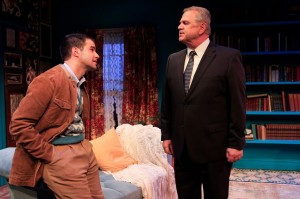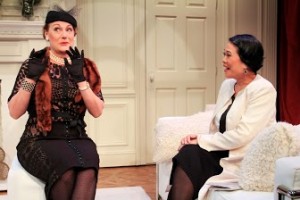Philip Goes Forth, George Kelly’s Depression era comedy-drama, chronicles a conventional young man’s plunge into bohemian New York. Back in 1931, when the play premiered, Kelly’s work was as popular and as integral to American culture as that of his fellow Pulitzer Prize recipient Eugene O’Neill. Today he's remembered principally, if at all, as an uncle of Grace Kelly, the Oscar-winning movie star whose 1956 wedding to Prince Rainier revived the economic fortunes of Monaco by bringing worldwide attention (and flocks of tourists) to that Mediterranean principality. Ah, the ironies of history.
In George Kelly’s day, Broadway audiences were accustomed to playwrights easing them gingerly into the dramatic action. Philip Goes Forth opens with something few writers would risk today: 40 minutes of solid exposition, including backstory disclosures by a conveniently loquacious parlor maid.
Just out of college, Philip Eldridge (Bernardo Cubría) has returned to his hometown, 500 miles from New York. He's training as an executive at his father’s firm (precise business unspecified) but longs to be in show biz. Philip's Babbitt-like father (Cliff Bemis) thinks his son should be grateful that he’s got a secure job in the midst of the Depression. The “old man” scoffs at Philip's declaration that he wants to write plays; the young man packs up his wounded pride and heads for Manhattan.
With the first act dedicated to set-up, Philip Goes Forth finally gets going in Act Two, when the protagonist takes refuge in a Murray Hill rooming house where all inhabitants have artistic aspirations. His compatriots include a hack writer (Teddy Bergman), an unsuccessful composer (Brian Keith MacDonald), and one person – a poet – with a genuine gift (Rachel Moulton). Their little community is overseen by a former stage star (Kathryn Kates), sympathetic to the challenges and disappointments faced by those in the arts.
Kelly’s theme in Philip Goes Forth is the contrast between genuine artists and the mere wannabes who are drawn to la vie de bohème but lack the vision, passion, or application necessary to create anything worthwhile. In an earlier play (and Broadway hit), The Torch-Bearers (1922), Kelly lampooned the pretensions of suburban aesthetes. The masterstroke of that Kelly classic is the magniloquent Mrs. J. Duro Pampinelli, director of a thoroughly awful Little Theater group. Mrs. Pampinelli, vividly drawn by the playwright (and catnip to generations of character actresses), is the very model of a hick-town culture-vulture. Philip Goes Forth – like The Torch-Bearers — pokes fun at pseudo-artists and the Philistines who love them. The characters of Philip Goes Forth, however, lack the intricacy and gusto of Mrs. Pampinelli; they represent ideas with which Kelly is grappling, but don't spring to life like the best of the playwright's creations.
Director Jerry Ruiz and his ten actors work hard to give Kelly's lackluster script a patina of professionalism. Cubría plays the title role with gung-ho energy and the earnestness of the adolescent hero in a Horatio Alger novel. As Philip's odyssey progresses, the actor re-calibrates his performance to reflect all the young man is learning in the New York School of Hard Knocks. Cubría woos ingénue Natalie Kuhn with an innocence — or, rather, naivety — that’s at once daffy and believable. Kuhn, who manages to be both dewy-eyed and down-to-earth, lends credibility to sweet banalities, such as: “I think it’s wonderful that you should want to do something on your own. After all, [your father’s] achievement isn’t yours. And you’re a man, as well as he is… I should think he’d respect you all the more for it.”
Bemis, Moulton, and Christine Toy Johnson (as Philip’s sympathetic aunt, Mrs. Randolph) give notably engaging performances. Carole Healey, playing a two-faced society matron (Mrs. Oliver), has two scenes of high comedy in which the tone of Kelly's writing is somewhat out of kilter with the rest of the play. Flamboyant but not quite over-the-top, Healey imbues the flat character of Mrs. Oliver with surprising dimension and gets the evening's loudest, most prolonged laughs. When events stray down a melodramatic path, neither Kelly nor the slightly uneven supporting cast are at their best.
Steven C. Kemp (sets), Christian DeAngelis (lights) and Joshua Yocom (props) evoke the 1930s in contrasting scenic designs for a provincial living room in Act One and the townhouse of the second and third acts. The former is all right angles, unadorned and startlingly white; the townhouse has deep, warm hues, oblique lines and exotic bric-a-brac. The handsome costumes by Carisa Kelly enhance the production's period flavor. Contemplating the extremes of old-fashioned formality with which the designer has clothed her actors while also listening to the handful of speeches that are most alien to a 2013 sensibility, playgoers may be perplexed. Does what's stilted and jejune in Philip Goes Forth reflect merely the social rigidity of the era the dramatist is depicting or a limitation in Kelly's craft? Those acquainted with other works by the playwright, especially The Torch-Bearers and The Show-Off (1924), are likely to give him the benefit of the doubt.
The Mint Theater Company focuses on plays that have been neglected and, in some cases, forgotten. For 18 years, this troupe, under producing artistic director Jonathan Bank, has resurrected worthy dramas. Though not likely to be remembered as one of the company's most valuable rediscoveries, Philip Goes Forth is a diverting piece by a playwright who ought to be more than a footnote in the biography of Princess Grace.



